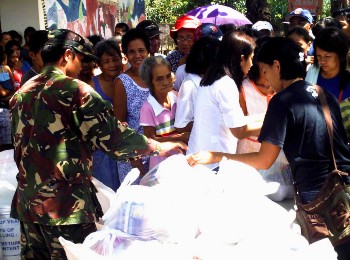About 1 result/s

-
Volume 5, Issue 1, March 2022
Bringing aid to disaster-stricken communities is complex, especially in the Philippines where destructive typhoons are intensifying due to climate change. This paper illustrates the coordination for humanitarian aid from Philippine government instrumentalities, the military, uniformed personnel, and civilian sectors as well as from, multilateral organizations and non-government organizations, both local and international during state of national calamities like Typhoon Haiyan. Disaster response increases in complexity in conflict zones such as Bangsamoro Autonomous Region of Muslim Mindanao (BARMM), where armed non-state actors have been active for many years. Encapsulated are the perceptions of 30 respondents coming from government agencies involved in disaster risk reduction and management, including the military and uniformed personnel including humanitarian and relief agencies, during both peacetime and conflict. This embodies challenges in civil-military engagement in balancing mandated tasks such as security, maintaining peace and order, preserving sovereignty, and preventing terrorism with adherence to humanitarian principles and frameworks even while striving to deliver basic humanitarian services in the nexus of climate change and conflict.

-
Volume 3, Issue 1, August 2018
In 2013, Super Typhoon Haiyan, one of the strongest tropical
cyclones to impact the Philippines, made landfall in Tacloban City. The typhoon
incapacitated the city, breaking down its main lifeline, the transport system.
This article analyzes how a weakened transport system exacerbates disaster
vulnerability, specifically manifested in the restricted mobility and access of
people and communities immediately after an extreme event.
-
Volume 3, Issue 1, February 2018
Tacloban, Philippines, the city most devastated by typhoon Haiyan in 2013, faces severe water supply constraints, particularly on the relocation sites that are expected to accommodate 40% of Tacloban's population by 2018. This study assess the impacts of climate change on the hydrological system on which Tacloban relies for water supply purposes.
-
Volume 3, Issue 1, August 2017
Philippine reefs are mega-diverse but, to date, few ecosystem models have been developed to understand their dynamics and functioning. This study assessed the status of reefs in 12 municipalities of Leyte Gulf, Philippines.
-
Volume 1, Issue 1, January 2016
Recent extreme weather events have brought devastating impacts on people’s lives and infrastructure in many parts of the world. The scale of the impact of Typhoon Haiyan in the Philippines revealed a high degree of vulnerability and exposure of coastal communities to extreme events in a region that is regularly hit by tropical cyclones.
-
Volume 1, Issue 1, January 2016
Climate-related hazards can lead to disasters in communities with lower socioeconomic conditions, inadequate access to basic social and infrastructure services, and poor institutions. The impacts of Typhoon Haiyan that struck the Philippines in 2013 not only highlighted the exposure of several cities but also indicated the underlying causes of their social vulnerability to climate-related hazards.
-
Volume 1, Issue 1, December 2015
The destruction caused by Typhoon Haiyan in the coastal areas of central Philippines drew greater international attention to the vulnerability of coastal communities to extreme weather and climate events. Mangrove ecosystems enhance coastal resilience by acting as barriers against storms and its impacts.
-
Volume 1, Issue 1, December 2015
The destruction left by Typhoon Haiyan in the Philippines highlighted not only the exposure of the country but also the underlying vulnerability of barangays (villages) to climate-related hazards. This study utilized Geographic Information System (GIS) to characterize social vulnerability to climate-related hazards of barangays of Tacloban City and Ormoc City using a modified social vulnerability index (SoVI).
-
Volume 1, Issue 1, November 2015
Tacloban City is one of the hardest hit cities of the 2013 Super Typhoon Haiyan. Aside from the recorded thousands of death, Haiyan is predicted to have altered the terrestrial ecology of the affected area. In particular, this study investigated the probable impact on water resources as a result of the change in forest cover resulting from Haiyan.
-
Volume 1, Issue 1, October 2015
Typhoons cause damage to mangrove ecosystems, hampering their delivery of ecosystem goods and services, including coastal protection. We examined the vegetation resistance (VR) and seedling regeneration potential (SRP) of three mangrove genera: Rhizophora, Sonneratia and Avicennia at the seafront areas..